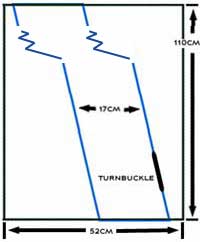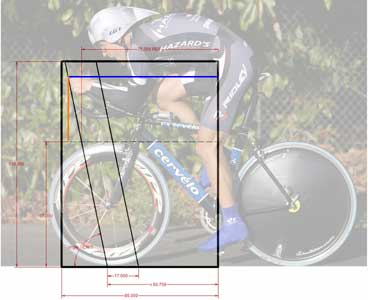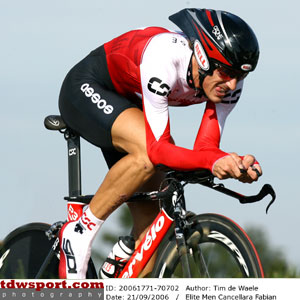X/Y Rules for cycling: After the “peer review”
The nice thing about the Internet — or the maddening thing, if you like finality — is that there rarely is any finality. Articles that we publish are not the last word on a subject, they're typically the first word.
A case in point is the article written last week on X/Y rules in an angular world. That caused a lively and instructive discussion on our reader forum, during which several improvements and enhancements were suggested. One person wisely offereed incorporating the saddle length restrictions into the rule. It was a brilliant idea and suggested text for the rule was generated. It was then a simple matter to alter the measuring jig used by a commissaire to account for this rule enhancement.
The suggested rule text is as follows, and would replace the text currently serving as rule 1.3.013 in the ITU rulebook:
"The nose of the saddle shall protrude no further forward than 18 centimeters in front of a line passing through the bottom bracket spindle and inclined rearward at an angle of 78 degrees from the horizontal."
The rule as suggested uses 78 degrees as the reference angle. The rule can read anything from 75 degrees to 81 degrees, depending on what the UCI thinks is most appropriate. The point, in any case, is that the rule would now be fair, and would not discriminate against shorter riders and against women, as it now does. I chose 78 degrees because it is midway between the shallowest and steepest seat angles riders adopt when they're able to choose a seat angle optimize for them during a timed event.

The rule not only injects fairness into the UCI rulebook, it also guards against athletes circumventing the rules by using an overlong saddle.
The measuring jig to be used by commissaires for the adjudication of this rule looks like the one proposed in the prior article, but adds a second wire. The "harp" proposed here might easily be constructed by welding together pieces of rectangular, U, or I-beam stock, with a single wire forming a parallelogram and attaching to itself with a turnbuckle used to make the wire taught. There are any number of ways to construct the harp, this is simply the first that came to mind.
The forum then commenced a discussion of rule 1.3.023 which, as we all know, discriminates against tall riders, by also applying an X/Y standard to those of every height, but allowing for morphological exceptions that, it appears, are unevenly enforced and, as with 1.3.013, are in most all cases proscribed for masters riders.
One ingenious solution was to build the measuring jig longer than is necessary so that it can serve to enforce both rules. In this case, the bike is flipped around after 1.3.013 is measured, and the harp's vertical member passes through the BB. The distal inclined wire serves to indicate the limit of the aerobar's frontal protrusion.

The idea is to incorporate scalability into the rule governing a rider's allowable distance from BB to bar tip. The proposed rule also allows for the use of the harp for to measure the bike for both rules.
The problems are two: it's not easy for a rider to determine his bike's legality without his having his own measuring jig; and it's just a guess as to whether 78 degrees, or 77, or 79, or whatever the UCI would choose as its maximum incline for seat angles, is also the appropriate angle for scaling up the max allowable bb-to-bar-tip as the rider's stature increases.
My simpler (and maybe simple-minded) idea is to make 1.3.023 a function of seat height. Coincidentally my saddle height (bb to top of saddle, halfway between the saddle's fore and aft) is the same distance as my cockpit length (saddle nose to bar tip). My morphology is average, and it is certainly foreseeable that riders with longer torsos and shorter legs might need a longer cockpit than I. So, would it be fair for 1.3.023 to be limited to saddle height + 5 centimeters? That would make the rule scalable, and easy to measure.
I have trade several emails with the UCI's technical chair. He's fain to entertain any consideration of rule changes during an Olympic year. While it seems to me fairness ought to be imposed before, and not after, the commencement of a significant competition, I am certainly sensitive to the constraints under which the UCI labors.
Accordingly, I have taken it upon myself to visit these issues now since, assuming the UCI's wisdom is greater than mine in these matters, the most appropriate time to change the rules is at the beginning of the next Olympic cycle. Since that will happen in about 10 months, best to start the discussion prior to that time: in other words, now.


